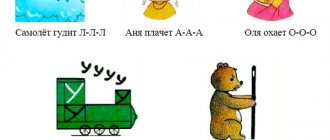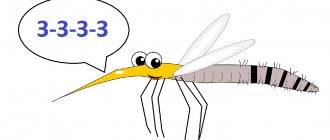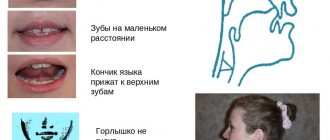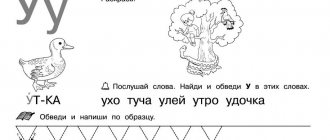Signs of violation
The main reasons for incorrect sound pronunciation in children are:
- hearing impairment, incorrect auditory differentiation of sounds;
- insufficient mobility of articulatory organs;
- violation of the anatomy of the articulatory apparatus;
- incorrect speech of people around the child;
- insufficient attention from adults to the child’s speech.
Defective pronunciation of the sounds K, G, X, belonging to the same phonetic group, is called monomorphic.
Violations of posterior lingual sounds are expressed as follows:
- back-lingual sound G, replaced by K with southern Russian aspiration,
- sounds within the group are replaced - the sound K with the sound X or G with K,
- soft form Kb, can be replaced by side ones Db, Tb,
- there are no back-lingual consonants, for example, “us”, “ot” instead of “goose”, “cat”,
- the sounds are barely audible - when pronouncing K, G, the back of the tongue does not close with the palate.
Causes
Factors that provoke speech defects can be of a different nature:
- Organic. The hard palate is too narrow and high, making it difficult to form a dense lingual-palatal curtain. In other words, the tongue does not reach the roof of the mouth. Another reason is paresis of the hyoid muscle;
- Functional. The child is in an inferior speech environment. Incorrect pronunciation occurs as a result of defeat.
Often the cause of impaired pronunciation of sounds is disorders of the central nervous system. They are accompanied by problems with articulatory motor skills (dysarthria). It manifests itself in the form of a decrease in the tone of the articulatory (styloglossus, stylohyoid, digastric, stylthyroid) muscles responsible for pronunciation. Hyperkinesis of the tongue, voice formation disorders, synkinesis, etc. may also be observed.
Taping treatment
Often, it is difficult for a child to correctly pronounce those sounds that are most complex in articulation - differentiated movement of the speech organs is required.
In such cases, speech therapy taping is recommended, which provides:
- accelerated production of sound/sounds,
- improving blood circulation in the articulatory apparatus,
- increased tissue innervation,
- impact on voice function,
- solving problems associated with swallowing and hypersalivation.
The effect of taping is noticeable after the first procedures. The essence of the procedure is the application of special elastic hypoallergenic tapes made of 100% cotton or artificial silk, cross-tapes. With their help, the possibility of continuous therapeutic and corrective effects is provided for 3-5 days. The elasticity of the tapes ensures comfortable wearing. The ability to choose children's designs and colors makes the procedure more enjoyable for the child.
Peculiarities of work on production of back-lingual sounds in children with dysarthria article on speech therapy
Staging sounds.
Rear lingual:
Setting the sound "K". The “K” sound should be placed mechanically using a finger or spatula, based on the “T” sound. In this case, the sound “T” should be “pure” for the child, that is, pronounced without overtones. The child is asked to pronounce the syllable “TA”. At the moment of pronunciation, the teacher presses his finger on the front part of the back of the tongue, resulting in the syllable “TYA”. Then the teacher moves the finger a little deeper, resulting in the syllable “KY”.
Finally, the third stage - even deeper pressure on the tongue - produces a hard sound - “KA”. Quite often there are such cases: as soon as the teacher brings his finger closer to the child’s mouth, the child immediately moves his tongue into the back of his mouth - hides his tongue from the teacher. In such cases, the teacher must accustom the child to the finger. To do this, he asks the child to pronounce the syllable “TA”, and he just puts his finger on the tip of his tongue without pressing it. The child should be trained in this way until he learns not to push the tip of his tongue back in this position. Then the teacher begins the work described above on setting the sound “K”. At first, the teacher uses only his finger for production, but as soon as the sound “K” is obtained correctly with his help, he teaches the child to use his own finger. The mechanical effect on the tongue should not be stopped too early, otherwise various defects in the pronunciation of k can easily take root, for example, a soft sound or the sound “K” with a guttural connotation.
Making the sound “X” when replacing it with “T”.
Pay attention to the fact that the sounds are different in the place of formation and in the method. The sound “T” is plosive, labial-dental, and the sound “X” is fricative, posterior lingual. Play with these features: perform the production slowly from the combination “HK”. Or ask the child to round his lips, then place the tip of his tongue behind the lower incisors, make the tongue “slide” and let the wind blow. From the book by V.M. Akimenko “Correction of sound pronunciation in children”
Making the sound "K" from "T".
Using a frame probe or spatula, start from the syllable “ta”. Moving the tip of the tongue with a probe inside the mouth, we hear “kya” at the beginning, then “ka”.
Making the sound “K” while inhaling.
1. While inhaling, the child should “suck” the tongue as far into the throat as possible, “like a snail into a shell.” Show him how to do this, while inhaling you should pronounce syllables that are close in sound to the sound combination [ka - ka - ka]. 2. This can also be compared to a silent (whispering) imitation of snoring, just make sure that in your pronunciation there is no rolling throat sound reminiscent of the grating sound [r] (after [k] you can hear a short aspirated sound reminiscent of [x]). You can pronounce a sound that is as close as possible to the sound [k].3. In the future, let the child pronounce the syllable [ka] first while inhaling and then exhaling (“sucked in the snail - now let it out” or “snorled in - now out”). In order to avoid the appearance of a booming pronunciation, the syllables must be pronounced very quietly, in a whisper (so as not to wake up someone sleeping nearby with your snoring).4. When the child pronounces the syllable [ka] freely as he exhales, tell him what sound he is making and let him repeat it after you in isolation.5. Then practice pronouncing the sound [k] in syllables with other vowels and only while exhaling. The child should repeat the syllables after you.
The material is taken from the book by M. Polyakova “Self-instruction manual on speech therapy. Universal benefit"
Making the sound “K” from the correct “X”. 1. Draw the child’s attention to the fact that when he carefully pronounces the sound [x], the root of his tongue touches the palate; let him feel this place with his tongue. It is necessary that during a long, drawn-out pronunciation of the sound [x], the child, in the place where he feels the touch of the tongue on the palate, clamps the gap with it and blocks the flow of air, as if “putting a point there” with the tongue.2. Under the formed bow, the air stream will be under some pressure. At this moment, the child, coughing slightly, should exhale it from his mouth into his palm, as a result the sound [k] will be heard. 3. In the future, the child should immediately press the root of the tongue against the gap in the throat and pronounce the sound [k]. If the sound turns out to be too “explosive” or intense, and also if it has an aspirated tone, you need to practice whispering its pronunciation (in a whisper - “cough” barely audible, almost without exhaling, eliminating the middle overtone [x] from your pronunciation). The child should repeat behind you. This should be done after a complete exhalation).4. After the child produces a sound fluently, tell him what sound he has learned to pronounce.5. Then move on to pronunciation of syllables (by imitation).
Making the sound “K” by imitation.
1. The child should “cough” after you. Open your mouth wide so that the child can see how your tongue is positioned, and, exhaling air, imitate a slight cough (the kind that happens when the throat is sore), with a noticeable sound [k] ([cough]). You need to “cough” quietly with minimal exhalation, then between the sounds [k] and [e] there will be no pronounced sound [x], but only a slight aspiration will be heard. Repeating the exercise after you, the child should “cough” into his palm.2. With your thumb and forefinger you can apply some pressure to his neck in the throat area just under the chin. This will make the sound [k] when “coughing” more distinct.3. After this, show your child how to “cough” in a whisper - “cough” barely audibly, almost without exhaling, eliminating the middle sound [x] from your pronunciation. The child should repeat after you. This should be done after a complete exhalation.4. If the correct sound [k] is obtained, that is, the child actually pronounces the syllable [ke], after practicing it, move on to syllables with other vowel sounds. You can give the following instructions: “Now we will cough like this: [ka - ka - ka]” 5. At the end, pronounce the sound in isolation, let the child repeat it after you.









